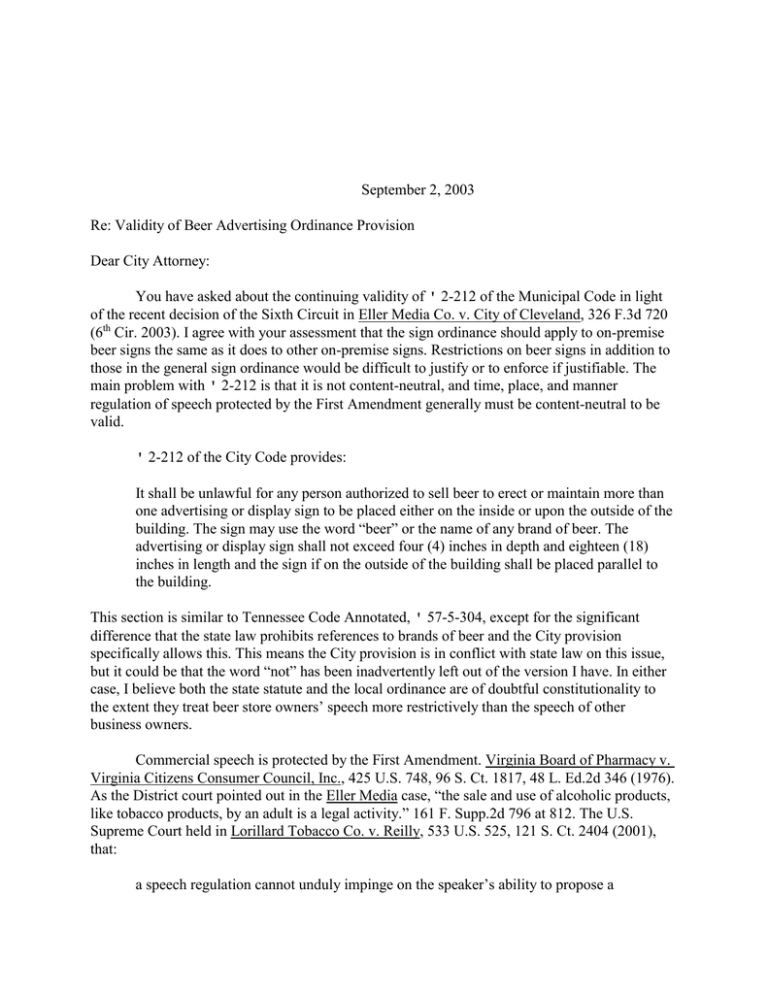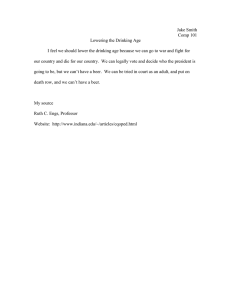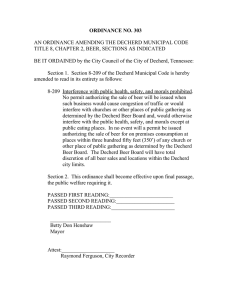September 2, 2003 Re: Validity of Beer Advertising Ordinance Provision
advertisement

September 2, 2003 Re: Validity of Beer Advertising Ordinance Provision Dear City Attorney: You have asked about the continuing validity of ' 2-212 of the Municipal Code in light of the recent decision of the Sixth Circuit in Eller Media Co. v. City of Cleveland, 326 F.3d 720 (6th Cir. 2003). I agree with your assessment that the sign ordinance should apply to on-premise beer signs the same as it does to other on-premise signs. Restrictions on beer signs in addition to those in the general sign ordinance would be difficult to justify or to enforce if justifiable. The main problem with ' 2-212 is that it is not content-neutral, and time, place, and manner regulation of speech protected by the First Amendment generally must be content-neutral to be valid. ' 2-212 of the City Code provides: It shall be unlawful for any person authorized to sell beer to erect or maintain more than one advertising or display sign to be placed either on the inside or upon the outside of the building. The sign may use the word “beer” or the name of any brand of beer. The advertising or display sign shall not exceed four (4) inches in depth and eighteen (18) inches in length and the sign if on the outside of the building shall be placed parallel to the building. This section is similar to Tennessee Code Annotated, ' 57-5-304, except for the significant difference that the state law prohibits references to brands of beer and the City provision specifically allows this. This means the City provision is in conflict with state law on this issue, but it could be that the word “not” has been inadvertently left out of the version I have. In either case, I believe both the state statute and the local ordinance are of doubtful constitutionality to the extent they treat beer store owners’ speech more restrictively than the speech of other business owners. Commercial speech is protected by the First Amendment. Virginia Board of Pharmacy v. Virginia Citizens Consumer Council, Inc., 425 U.S. 748, 96 S. Ct. 1817, 48 L. Ed.2d 346 (1976). As the District court pointed out in the Eller Media case, “the sale and use of alcoholic products, like tobacco products, by an adult is a legal activity.” 161 F. Supp.2d 796 at 812. The U.S. Supreme Court held in Lorillard Tobacco Co. v. Reilly, 533 U.S. 525, 121 S. Ct. 2404 (2001), that: a speech regulation cannot unduly impinge on the speaker’s ability to propose a commercial transaction and the adult listener’s opportunity to obtain information about products. 533 U.S. at 565. The Court in Lorillard also points out that “tobacco retailers and manufacturers have an interest in conveying truthful information about their products to adults... .” 533 U.S. at 2426. The same can be said for beer retailers, as Eller Media does. Commercial speech is subject to valid time, place, and manner regulation. Members of City Council of Los Angeles v. Taxpayers for Vincent, 466 U.S. 789, 104 S. Ct. 2118, 80 L. Ed.2d 772 (1984). Time, place, and manner regulations must be content- neutral. Ward v. Rock Against Racism, 491 U.S. 781, 109 S. Ct. 2746, 105 L. Ed.2d 661 (1989). Traffic safety and esthetics may serve as rationales for content-neutral regulation of signs. Metromedia, Inc. v. San Diego, 453 U.S. 490, 101 S. Ct. 2882, 69 L. Ed.2d 800 (1981). The traffic safety and esthetics rationales, which are probably the predominate rationales of the City’s sign ordinance, would not apply with any greater force to beer businesses than to other businesses insofar as the signs are attempting to convey truthful information to persons twenty-one (21) years of age or older. Therefore, in my opinion, the same on-premise sign regulations should apply to beer businesses as to other businesses with regard to these signs. The Eller Media case and other cases referred to above appear to leave some room for regulation of beer signs that goes beyond the regulations applicable to signs generally. The Court in Lorillard quotes Central Hudson Gas and Electric Corp. v. Public Service Commission of New York, 447 U.S. 557, 100 S. Ct. 2343, 65 L. Ed.2d 341 (1980) as follows: For commercial speech to come within that provision, it must at least concern lawful activity and not be misleading. Lorillard, 533 U.S. at 554, quoting Central Hudson, 447 U.S. at 566. “That provision” referred to in this quotation is the First Amendment. Thus, signs that are not truthful or that are specifically aimed at encouraging persons under twenty-one (21) years of age to drink beer probably can be regulated. Probably the requirement for truthfulness would have to apply to all business signs, not just those of beer places. Enforcing either of these regulations, however, could be problematic. Truth, like beauty, is sometimes in the eye of the beholder, especially when it comes to advertising, where puffery is often expected. And it would be difficult to prove that a sign specifically encouraged the illegal consumption of beer by minors unless the sign was blatant or the City had statistics showing a particular technique used in the sign disproportionately appealed to minors. Either of these situations is unlikely, although an ordinance prohibiting these practices could discourage such signs in the first place. Beer signs are subject to greater regulation than signs of other businesses because it is illegal for persons under twenty-one (21) to drink beer and signs that specifically encourage an illegal transaction are not protected by the First Amendment. A regulation that went beyond prohibiting this illegal appeal to minors under twenty-one (21) and discouraged the proposal of legal commercial transactions by adults would probably be too broad and therefore unconstitutional. I hope this is helpful. If we may be of further assistance, please contact us. Sincerely, Dennis Huffer Legal Consultant


